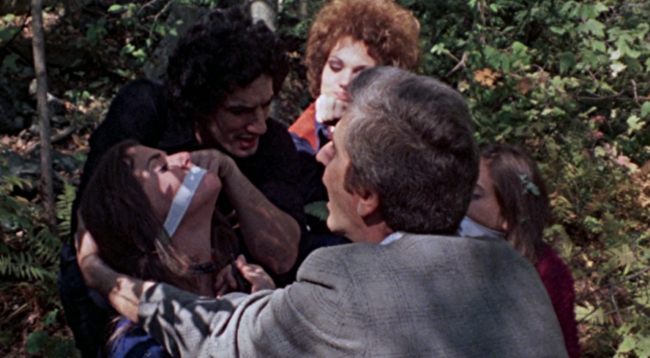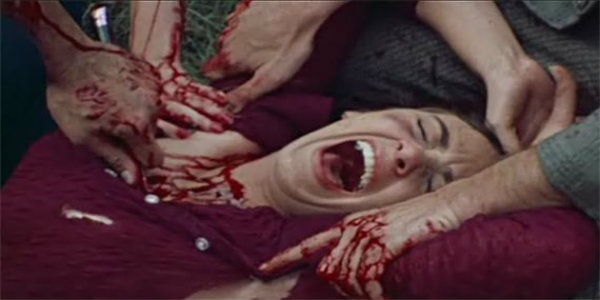The Last House on the Left is 1972 horror film about two teenage girls who head to a rock concert for one’s birthday, then kidnapped and brutalized by a gang of psychotic convicts.
Leaving an audience shocked, horrified and disgusted by the scenes they are witnessing is one way to ensure a film forever has a place in the history of cinema, and also the history of the audience’s memory. Wes Craven is most popularly known for his horror film A Nightmare on Elm Street, which is considered a classic, that although is scary, doesn’t quite sit into the controversial or boundary pushing circle. Why? Because it only brandishes traditional horror tropes, and doesn’t venture into topics that have always been deemed a reason to incite discussion amongst fans and critics. However, Craven did also create a film that became notorious for being extreme … The Last House on the Left.
The film was released in 1972, and follows two friends as they go to a rock concert in the city. When they try to buy some marijuana, they become entrapped in a deadly situation as they’re held in an apartment by a group of men and a woman, who have no plans to party with them unless it involves depravity. They bound the two girls and take them into the woods where they brutally gang rape them repeatedly, and abuse them violently until both are murdered and left to never be found. After the barbarous attack, they stop by a home which happens to be the family home of one of the girls. The parents soon realise that this gang have done something awful to their daughter, which is confirmed by the fact one of them is wearing their daughter’s necklace. From here, both parents decide to commit a bloody revenge on those who murdered their daughter and her friend; and their revenge holds nothing back…

For most people that have ever seen The Last House on the Left, they will tell you that it’s a bleak film one that poses nothing other than brutality and a test in endurance of watching atrocities. Seeing these two girls be raped and tortured with no hope on the horizon for either of them leaves the audience with an immoral feeling in their stomach, but what is it about The Last House on the Left that really leaves people feeling uncomfortable? Especially when we’ve already covered other films that are far more provocative? The particular moment (or moments as is the case with this film) that really plays on our minds and pushes our boundaries are those including rape. As a female myself, it’s never going to be a topic that I can say I feel “comfortable” with, however it’s something that needs to be addressed when looking at why this film is particularly difficult to watch. Craven would have known when approaching this issue that it would have caused controversy and put his film in a negative light, however, he aims to redeem the movie with his use of revenge, which is carried out by the parents of one the girls, and for us, it always feels satisfying seeing the sickening monsters of a movie treated to acts that are just as horrific. Yet even with this counteraction through the film, it still doesn’t take away the feeling we are subjected to when watching scenes of extreme rape – something that many other films use in their storytelling to poke the audience and get them to feel things they might not be so comfortable with.

Another film that uses this style to invoke moral sensibility is Irreversible, which features a 9-minute long rape scene that leaves a bitter taste well after it’s over. Certain titles feature these tests of endurance for many reasons, often being that they are the sole reason for the rest of the film to exist, and therefore the plot needs the audience to see something brutal and horrific to help understand what follows. In Irreversible, the rape scene is a pivotal moment, one that gives motivation for the unrelenting violence that opens the story, and therefore means the audience must see something that pushes them beyond comprehension, into a bleak state of mind in order to better understand what these characters do in the aftermath.
READ MORE: Boundary Pushing in the Controversial Serbian Film
Another film released in the 70s that sparked controversy was I Spit On Your Grave, which followed a similar trend by forcing the audience to be privy to some of the worst acts of depravity against women. These include sexual violence and assault, leading to only to a conclusion where revenge is mounted against the monsters treating women like meat. Although sitting through the scenes in The Last House on the Left is nothing to be enjoyed, the audience is at least rewarded for putting themselves through such an ordeal in seeing villains of the story subject to violence nearly on the same level of as committed against the two girls.

But why does an audience want to watch a film like this in the first place? Why are we searching to see depraved acts committed and then rewarded with further violence against the perpetrators? Humans have a tendency to love the ideology of revenge and seeing the monsters of society left to burn, as they should be. However, in our everyday lives these acts of revenge are still against the law, and therefore we have to allow the justice system to carry out vengeance on our behalf. As rationals we will all agree that the justice system is a safe and moral way to ensure that the worst of society are dealt with in a way that we can accept, but there is no denying that we do not revel in seeing rapists, paedophiles and murderers hanged, drawn and quartered – something that we even used to partake in before we became a little more humane in our punishment rulings. Therefore it’s in our nature to be drawn to watch monsters commit their atrocities such as the gang rapes and subsequent murders witnessed in The Last House on the Left, only so we can have the sweet taste of revenge when we watch the mother of the girl cause fatal damage during fellatio. This reward for the audience is a bittersweet, and although it doesn’t strip away the impact of the initial heinous crimes, it makes us feel better knowing that these creeps met their maker. Thanks for reading.
